Advanced Auditing and Assurance 1: Audit Planning and Risk Report
VerifiedAdded on 2022/11/30
|12
|3218
|402
Report
AI Summary
This report addresses key aspects of advanced auditing and assurance, including audit planning for Yates & Co, focusing on risk assessment and material misstatements. It examines audit protocols for specific areas like land, factory, machinery, and capitalised construction costs. The report also discusses the use of an auditor's expert in the audit of biological assets, and provides recommendations for handling suspicious behavior. Furthermore, the report analyses audit risks for Finch Co, including audit strategy, materiality assessment, and resource allocation. It also evaluates internal controls, particularly in capital expenditure, and suggests enhanced audit procedures. Finally, the report outlines steps for forensic investigation in response to incidents, including evidence collection, preservation, and the establishment of a judicial board, as well as matters to be included in a tender document for Bull Co.
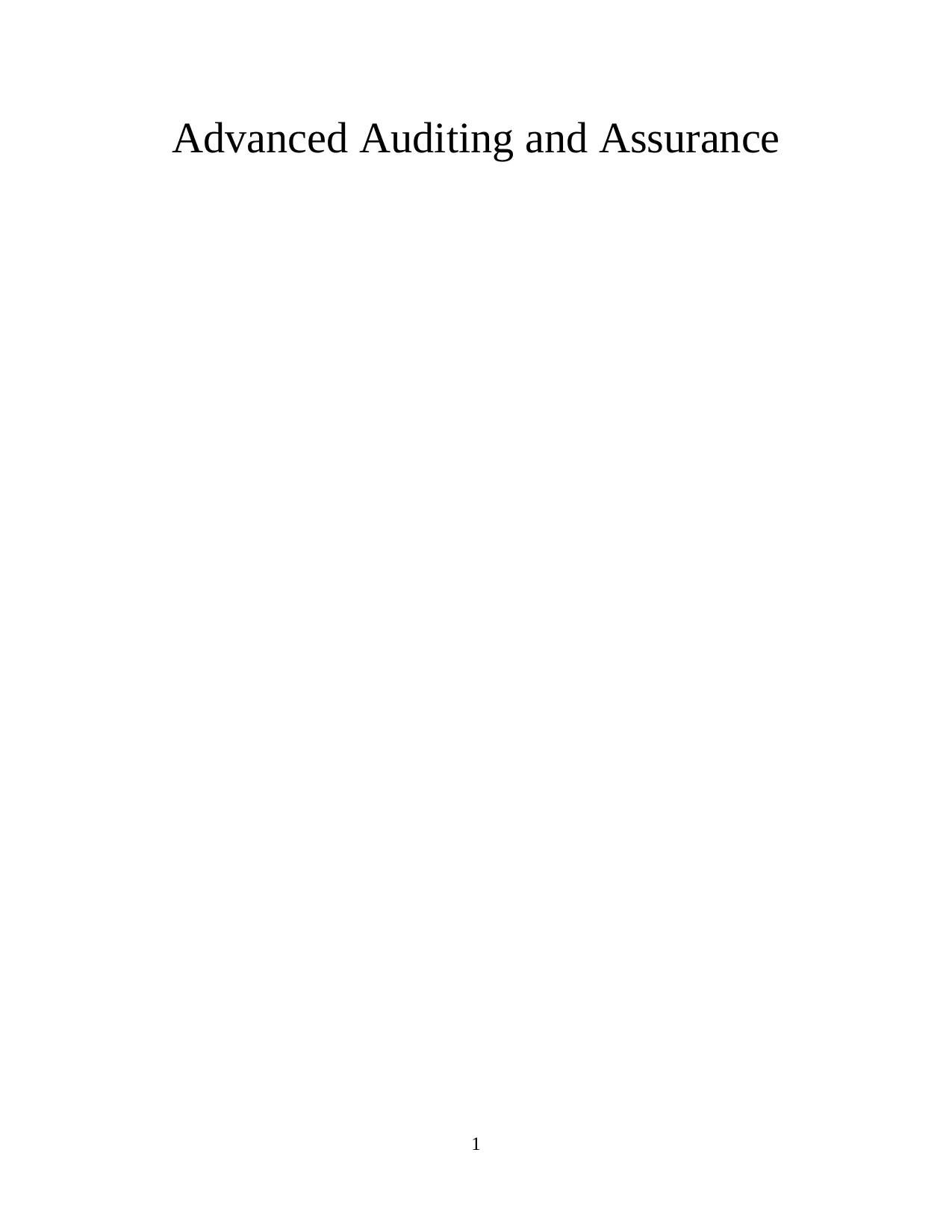
Advanced Auditing and Assurance
1
1
Paraphrase This Document
Need a fresh take? Get an instant paraphrase of this document with our AI Paraphraser
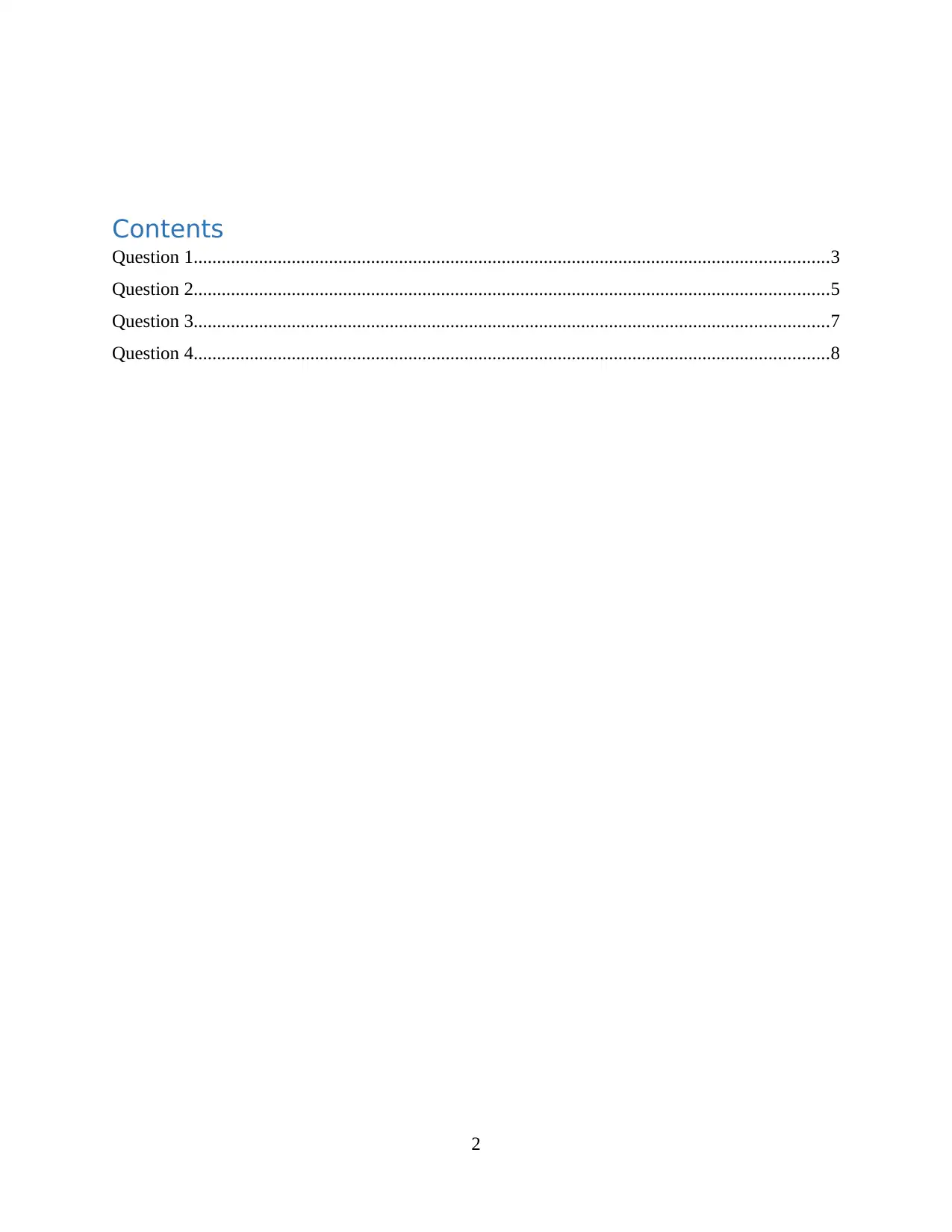
Contents
Question 1........................................................................................................................................3
Question 2........................................................................................................................................5
Question 3........................................................................................................................................7
Question 4........................................................................................................................................8
2
Question 1........................................................................................................................................3
Question 2........................................................................................................................................5
Question 3........................................................................................................................................7
Question 4........................................................................................................................................8
2
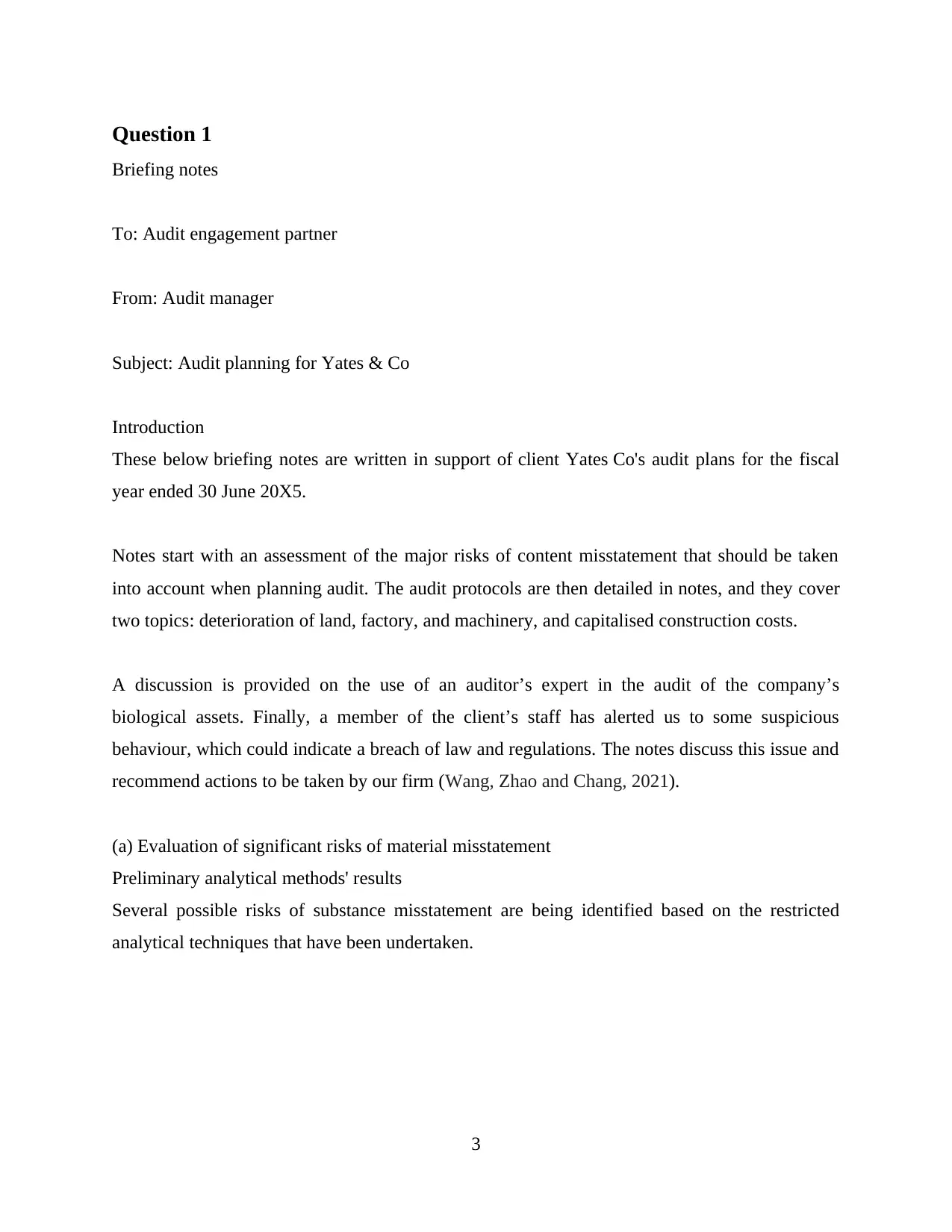
Question 1
Briefing notes
To: Audit engagement partner
From: Audit manager
Subject: Audit planning for Yates & Co
Introduction
These below briefing notes are written in support of client Yates Co's audit plans for the fiscal
year ended 30 June 20X5.
Notes start with an assessment of the major risks of content misstatement that should be taken
into account when planning audit. The audit protocols are then detailed in notes, and they cover
two topics: deterioration of land, factory, and machinery, and capitalised construction costs.
A discussion is provided on the use of an auditor’s expert in the audit of the company’s
biological assets. Finally, a member of the client’s staff has alerted us to some suspicious
behaviour, which could indicate a breach of law and regulations. The notes discuss this issue and
recommend actions to be taken by our firm (Wang, Zhao and Chang, 2021).
(a) Evaluation of significant risks of material misstatement
Preliminary analytical methods' results
Several possible risks of substance misstatement are being identified based on the restricted
analytical techniques that have been undertaken.
3
Briefing notes
To: Audit engagement partner
From: Audit manager
Subject: Audit planning for Yates & Co
Introduction
These below briefing notes are written in support of client Yates Co's audit plans for the fiscal
year ended 30 June 20X5.
Notes start with an assessment of the major risks of content misstatement that should be taken
into account when planning audit. The audit protocols are then detailed in notes, and they cover
two topics: deterioration of land, factory, and machinery, and capitalised construction costs.
A discussion is provided on the use of an auditor’s expert in the audit of the company’s
biological assets. Finally, a member of the client’s staff has alerted us to some suspicious
behaviour, which could indicate a breach of law and regulations. The notes discuss this issue and
recommend actions to be taken by our firm (Wang, Zhao and Chang, 2021).
(a) Evaluation of significant risks of material misstatement
Preliminary analytical methods' results
Several possible risks of substance misstatement are being identified based on the restricted
analytical techniques that have been undertaken.
3
⊘ This is a preview!⊘
Do you want full access?
Subscribe today to unlock all pages.

Trusted by 1+ million students worldwide
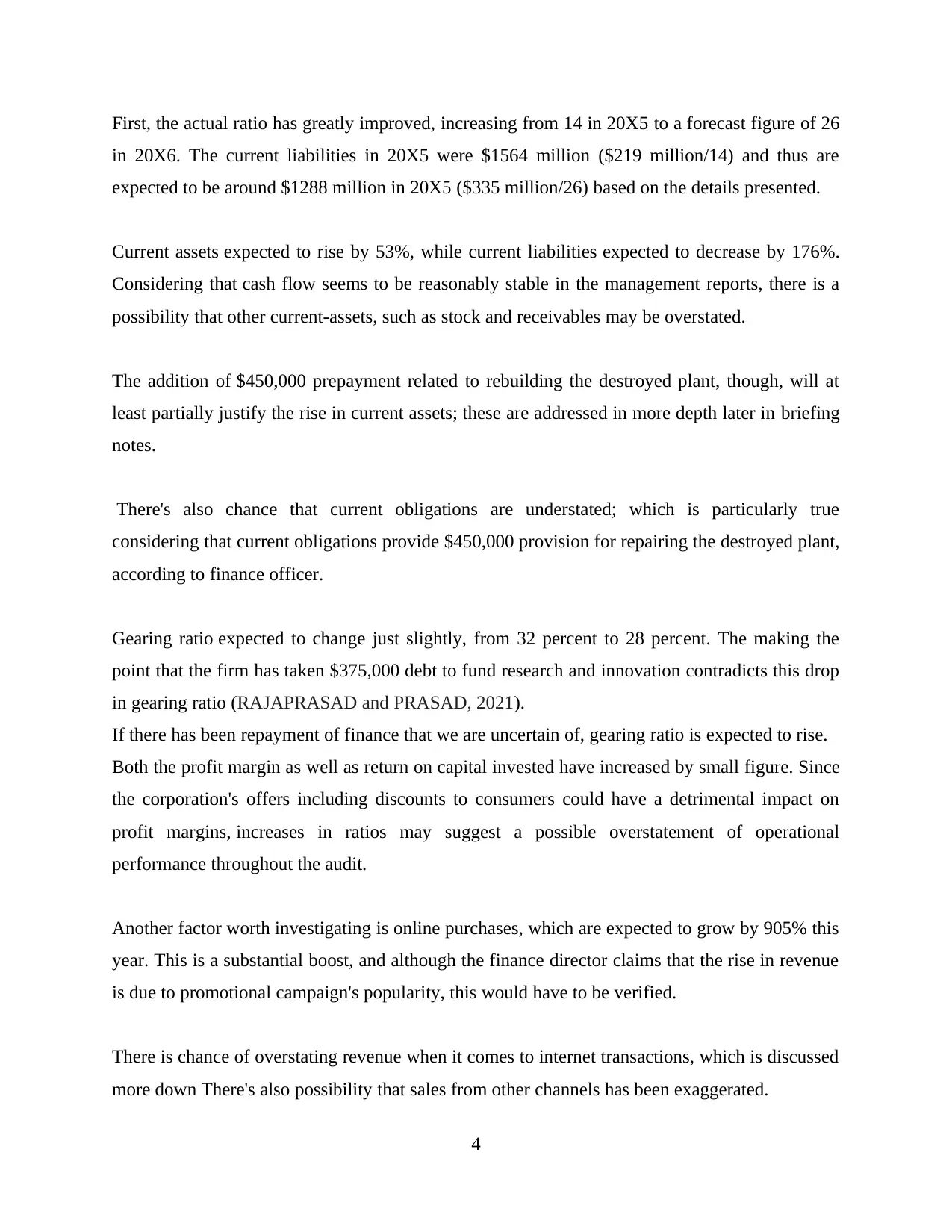
First, the actual ratio has greatly improved, increasing from 14 in 20X5 to a forecast figure of 26
in 20X6. The current liabilities in 20X5 were $1564 million ($219 million/14) and thus are
expected to be around $1288 million in 20X5 ($335 million/26) based on the details presented.
Current assets expected to rise by 53%, while current liabilities expected to decrease by 176%.
Considering that cash flow seems to be reasonably stable in the management reports, there is a
possibility that other current-assets, such as stock and receivables may be overstated.
The addition of $450,000 prepayment related to rebuilding the destroyed plant, though, will at
least partially justify the rise in current assets; these are addressed in more depth later in briefing
notes.
There's also chance that current obligations are understated; which is particularly true
considering that current obligations provide $450,000 provision for repairing the destroyed plant,
according to finance officer.
Gearing ratio expected to change just slightly, from 32 percent to 28 percent. The making the
point that the firm has taken $375,000 debt to fund research and innovation contradicts this drop
in gearing ratio (RAJAPRASAD and PRASAD, 2021).
If there has been repayment of finance that we are uncertain of, gearing ratio is expected to rise.
Both the profit margin as well as return on capital invested have increased by small figure. Since
the corporation's offers including discounts to consumers could have a detrimental impact on
profit margins, increases in ratios may suggest a possible overstatement of operational
performance throughout the audit.
Another factor worth investigating is online purchases, which are expected to grow by 905% this
year. This is a substantial boost, and although the finance director claims that the rise in revenue
is due to promotional campaign's popularity, this would have to be verified.
There is chance of overstating revenue when it comes to internet transactions, which is discussed
more down There's also possibility that sales from other channels has been exaggerated.
4
in 20X6. The current liabilities in 20X5 were $1564 million ($219 million/14) and thus are
expected to be around $1288 million in 20X5 ($335 million/26) based on the details presented.
Current assets expected to rise by 53%, while current liabilities expected to decrease by 176%.
Considering that cash flow seems to be reasonably stable in the management reports, there is a
possibility that other current-assets, such as stock and receivables may be overstated.
The addition of $450,000 prepayment related to rebuilding the destroyed plant, though, will at
least partially justify the rise in current assets; these are addressed in more depth later in briefing
notes.
There's also chance that current obligations are understated; which is particularly true
considering that current obligations provide $450,000 provision for repairing the destroyed plant,
according to finance officer.
Gearing ratio expected to change just slightly, from 32 percent to 28 percent. The making the
point that the firm has taken $375,000 debt to fund research and innovation contradicts this drop
in gearing ratio (RAJAPRASAD and PRASAD, 2021).
If there has been repayment of finance that we are uncertain of, gearing ratio is expected to rise.
Both the profit margin as well as return on capital invested have increased by small figure. Since
the corporation's offers including discounts to consumers could have a detrimental impact on
profit margins, increases in ratios may suggest a possible overstatement of operational
performance throughout the audit.
Another factor worth investigating is online purchases, which are expected to grow by 905% this
year. This is a substantial boost, and although the finance director claims that the rise in revenue
is due to promotional campaign's popularity, this would have to be verified.
There is chance of overstating revenue when it comes to internet transactions, which is discussed
more down There's also possibility that sales from other channels has been exaggerated.
4
Paraphrase This Document
Need a fresh take? Get an instant paraphrase of this document with our AI Paraphraser
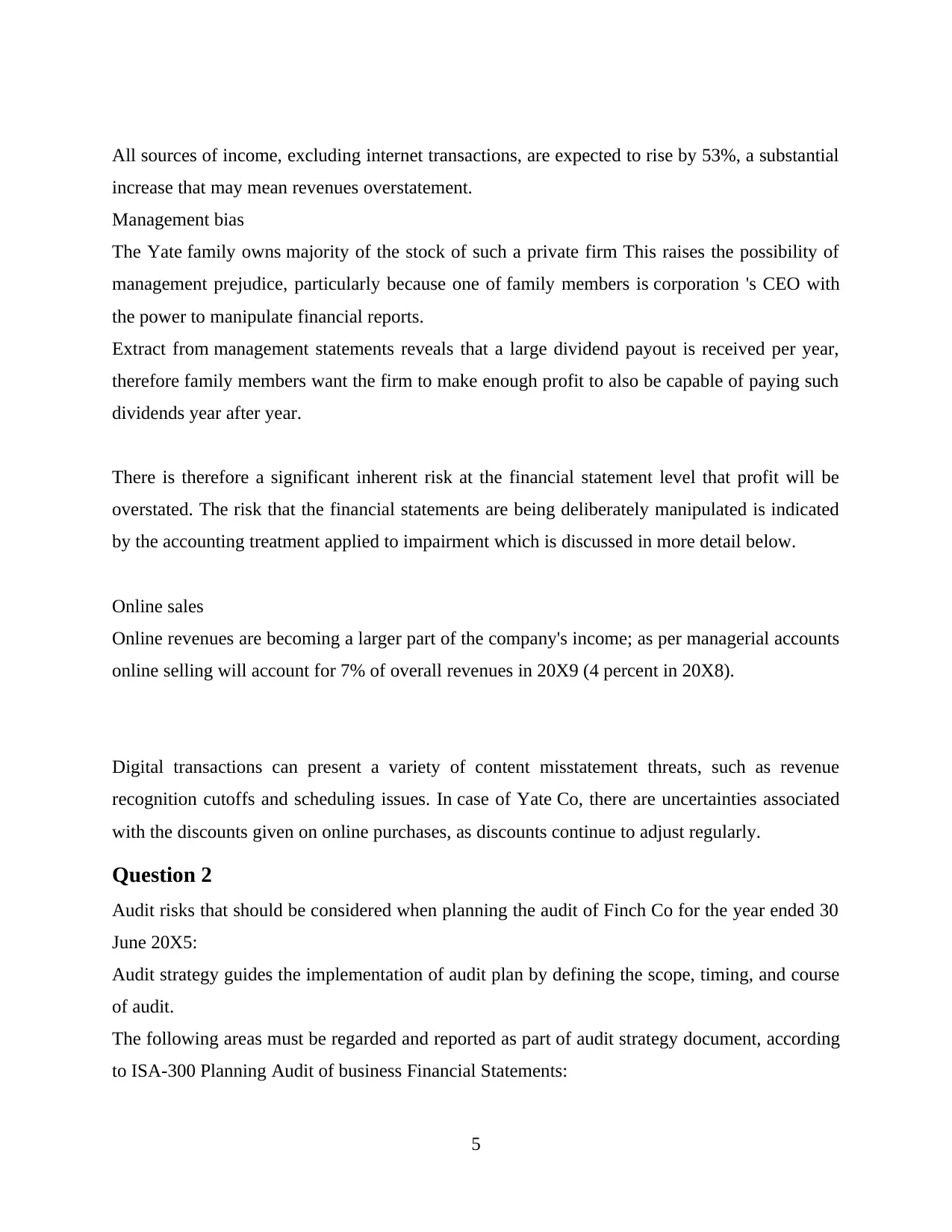
All sources of income, excluding internet transactions, are expected to rise by 53%, a substantial
increase that may mean revenues overstatement.
Management bias
The Yate family owns majority of the stock of such a private firm This raises the possibility of
management prejudice, particularly because one of family members is corporation 's CEO with
the power to manipulate financial reports.
Extract from management statements reveals that a large dividend payout is received per year,
therefore family members want the firm to make enough profit to also be capable of paying such
dividends year after year.
There is therefore a significant inherent risk at the financial statement level that profit will be
overstated. The risk that the financial statements are being deliberately manipulated is indicated
by the accounting treatment applied to impairment which is discussed in more detail below.
Online sales
Online revenues are becoming a larger part of the company's income; as per managerial accounts
online selling will account for 7% of overall revenues in 20X9 (4 percent in 20X8).
Digital transactions can present a variety of content misstatement threats, such as revenue
recognition cutoffs and scheduling issues. In case of Yate Co, there are uncertainties associated
with the discounts given on online purchases, as discounts continue to adjust regularly.
Question 2
Audit risks that should be considered when planning the audit of Finch Co for the year ended 30
June 20X5:
Audit strategy guides the implementation of audit plan by defining the scope, timing, and course
of audit.
The following areas must be regarded and reported as part of audit strategy document, according
to ISA-300 Planning Audit of business Financial Statements:
5
increase that may mean revenues overstatement.
Management bias
The Yate family owns majority of the stock of such a private firm This raises the possibility of
management prejudice, particularly because one of family members is corporation 's CEO with
the power to manipulate financial reports.
Extract from management statements reveals that a large dividend payout is received per year,
therefore family members want the firm to make enough profit to also be capable of paying such
dividends year after year.
There is therefore a significant inherent risk at the financial statement level that profit will be
overstated. The risk that the financial statements are being deliberately manipulated is indicated
by the accounting treatment applied to impairment which is discussed in more detail below.
Online sales
Online revenues are becoming a larger part of the company's income; as per managerial accounts
online selling will account for 7% of overall revenues in 20X9 (4 percent in 20X8).
Digital transactions can present a variety of content misstatement threats, such as revenue
recognition cutoffs and scheduling issues. In case of Yate Co, there are uncertainties associated
with the discounts given on online purchases, as discounts continue to adjust regularly.
Question 2
Audit risks that should be considered when planning the audit of Finch Co for the year ended 30
June 20X5:
Audit strategy guides the implementation of audit plan by defining the scope, timing, and course
of audit.
The following areas must be regarded and reported as part of audit strategy document, according
to ISA-300 Planning Audit of business Financial Statements:
5
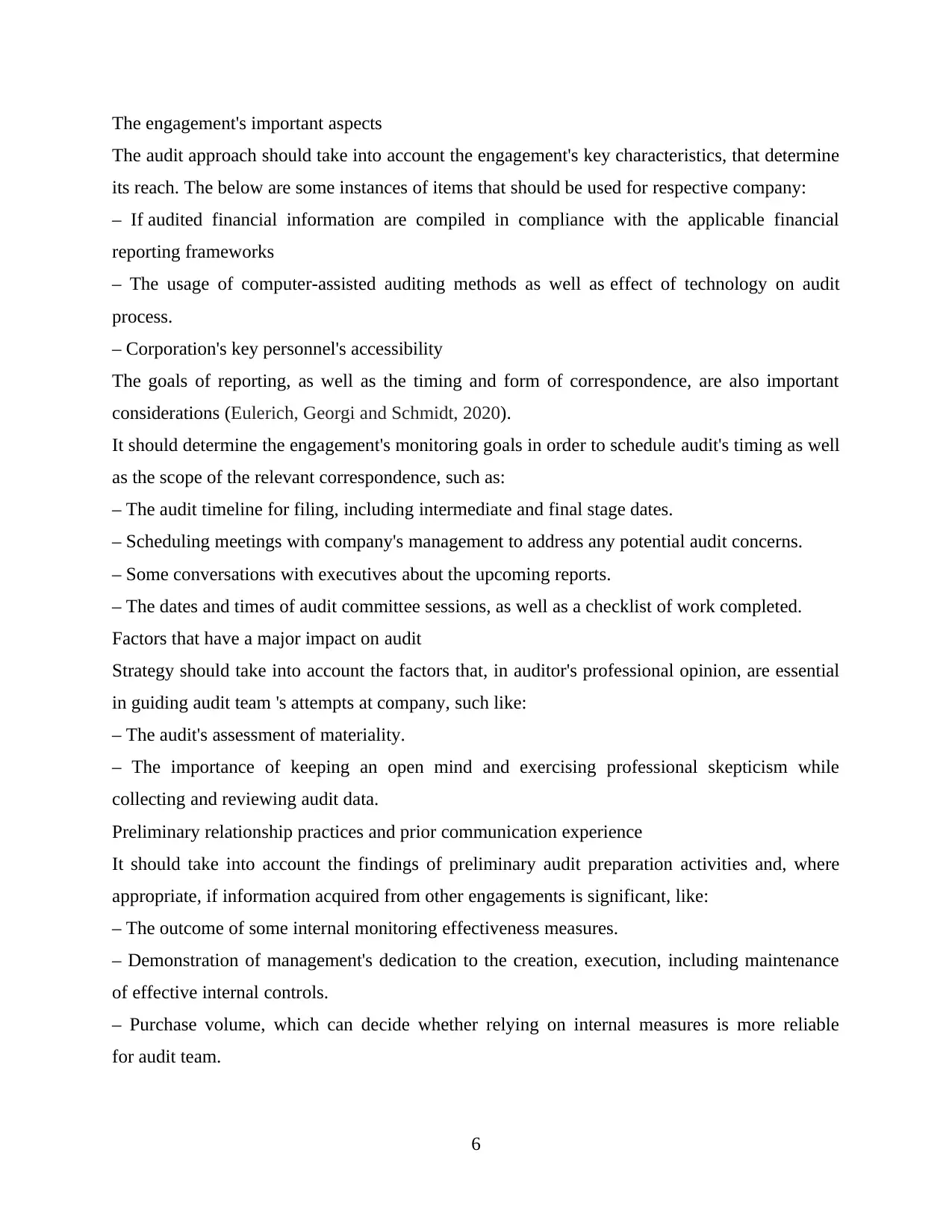
The engagement's important aspects
The audit approach should take into account the engagement's key characteristics, that determine
its reach. The below are some instances of items that should be used for respective company:
– If audited financial information are compiled in compliance with the applicable financial
reporting frameworks
– The usage of computer-assisted auditing methods as well as effect of technology on audit
process.
– Corporation's key personnel's accessibility
The goals of reporting, as well as the timing and form of correspondence, are also important
considerations (Eulerich, Georgi and Schmidt, 2020).
It should determine the engagement's monitoring goals in order to schedule audit's timing as well
as the scope of the relevant correspondence, such as:
– The audit timeline for filing, including intermediate and final stage dates.
– Scheduling meetings with company's management to address any potential audit concerns.
– Some conversations with executives about the upcoming reports.
– The dates and times of audit committee sessions, as well as a checklist of work completed.
Factors that have a major impact on audit
Strategy should take into account the factors that, in auditor's professional opinion, are essential
in guiding audit team 's attempts at company, such like:
– The audit's assessment of materiality.
– The importance of keeping an open mind and exercising professional skepticism while
collecting and reviewing audit data.
Preliminary relationship practices and prior communication experience
It should take into account the findings of preliminary audit preparation activities and, where
appropriate, if information acquired from other engagements is significant, like:
– The outcome of some internal monitoring effectiveness measures.
– Demonstration of management's dedication to the creation, execution, including maintenance
of effective internal controls.
– Purchase volume, which can decide whether relying on internal measures is more reliable
for audit team.
6
The audit approach should take into account the engagement's key characteristics, that determine
its reach. The below are some instances of items that should be used for respective company:
– If audited financial information are compiled in compliance with the applicable financial
reporting frameworks
– The usage of computer-assisted auditing methods as well as effect of technology on audit
process.
– Corporation's key personnel's accessibility
The goals of reporting, as well as the timing and form of correspondence, are also important
considerations (Eulerich, Georgi and Schmidt, 2020).
It should determine the engagement's monitoring goals in order to schedule audit's timing as well
as the scope of the relevant correspondence, such as:
– The audit timeline for filing, including intermediate and final stage dates.
– Scheduling meetings with company's management to address any potential audit concerns.
– Some conversations with executives about the upcoming reports.
– The dates and times of audit committee sessions, as well as a checklist of work completed.
Factors that have a major impact on audit
Strategy should take into account the factors that, in auditor's professional opinion, are essential
in guiding audit team 's attempts at company, such like:
– The audit's assessment of materiality.
– The importance of keeping an open mind and exercising professional skepticism while
collecting and reviewing audit data.
Preliminary relationship practices and prior communication experience
It should take into account the findings of preliminary audit preparation activities and, where
appropriate, if information acquired from other engagements is significant, like:
– The outcome of some internal monitoring effectiveness measures.
– Demonstration of management's dedication to the creation, execution, including maintenance
of effective internal controls.
– Purchase volume, which can decide whether relying on internal measures is more reliable
for audit team.
6
⊘ This is a preview!⊘
Do you want full access?
Subscribe today to unlock all pages.

Trusted by 1+ million students worldwide
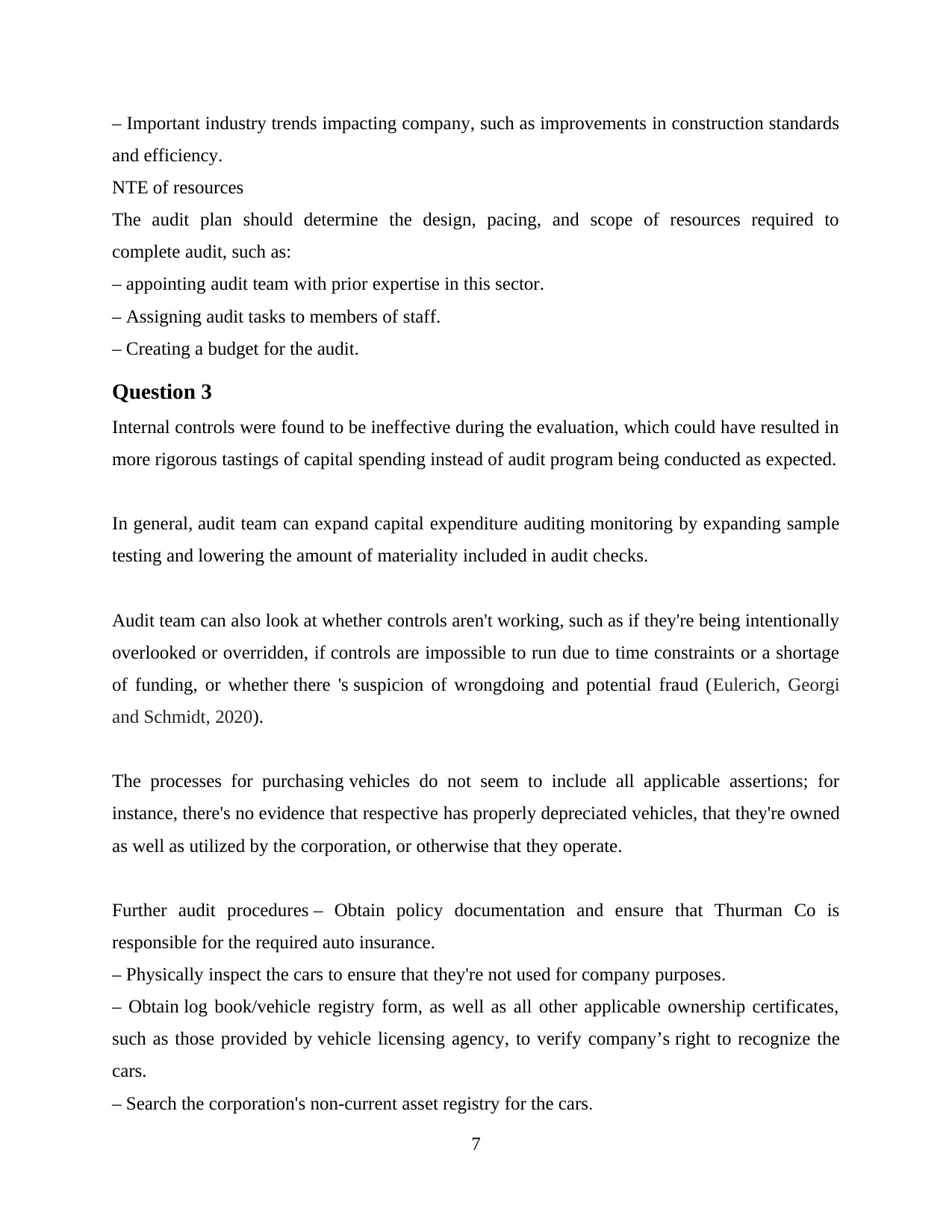
– Important industry trends impacting company, such as improvements in construction standards
and efficiency.
NTE of resources
The audit plan should determine the design, pacing, and scope of resources required to
complete audit, such as:
– appointing audit team with prior expertise in this sector.
– Assigning audit tasks to members of staff.
– Creating a budget for the audit.
Question 3
Internal controls were found to be ineffective during the evaluation, which could have resulted in
more rigorous tastings of capital spending instead of audit program being conducted as expected.
In general, audit team can expand capital expenditure auditing monitoring by expanding sample
testing and lowering the amount of materiality included in audit checks.
Audit team can also look at whether controls aren't working, such as if they're being intentionally
overlooked or overridden, if controls are impossible to run due to time constraints or a shortage
of funding, or whether there 's suspicion of wrongdoing and potential fraud (Eulerich, Georgi
and Schmidt, 2020).
The processes for purchasing vehicles do not seem to include all applicable assertions; for
instance, there's no evidence that respective has properly depreciated vehicles, that they're owned
as well as utilized by the corporation, or otherwise that they operate.
Further audit procedures – Obtain policy documentation and ensure that Thurman Co is
responsible for the required auto insurance.
– Physically inspect the cars to ensure that they're not used for company purposes.
– Obtain log book/vehicle registry form, as well as all other applicable ownership certificates,
such as those provided by vehicle licensing agency, to verify company’s right to recognize the
cars.
– Search the corporation's non-current asset registry for the cars.
7
and efficiency.
NTE of resources
The audit plan should determine the design, pacing, and scope of resources required to
complete audit, such as:
– appointing audit team with prior expertise in this sector.
– Assigning audit tasks to members of staff.
– Creating a budget for the audit.
Question 3
Internal controls were found to be ineffective during the evaluation, which could have resulted in
more rigorous tastings of capital spending instead of audit program being conducted as expected.
In general, audit team can expand capital expenditure auditing monitoring by expanding sample
testing and lowering the amount of materiality included in audit checks.
Audit team can also look at whether controls aren't working, such as if they're being intentionally
overlooked or overridden, if controls are impossible to run due to time constraints or a shortage
of funding, or whether there 's suspicion of wrongdoing and potential fraud (Eulerich, Georgi
and Schmidt, 2020).
The processes for purchasing vehicles do not seem to include all applicable assertions; for
instance, there's no evidence that respective has properly depreciated vehicles, that they're owned
as well as utilized by the corporation, or otherwise that they operate.
Further audit procedures – Obtain policy documentation and ensure that Thurman Co is
responsible for the required auto insurance.
– Physically inspect the cars to ensure that they're not used for company purposes.
– Obtain log book/vehicle registry form, as well as all other applicable ownership certificates,
such as those provided by vehicle licensing agency, to verify company’s right to recognize the
cars.
– Search the corporation's non-current asset registry for the cars.
7
Paraphrase This Document
Need a fresh take? Get an instant paraphrase of this document with our AI Paraphraser
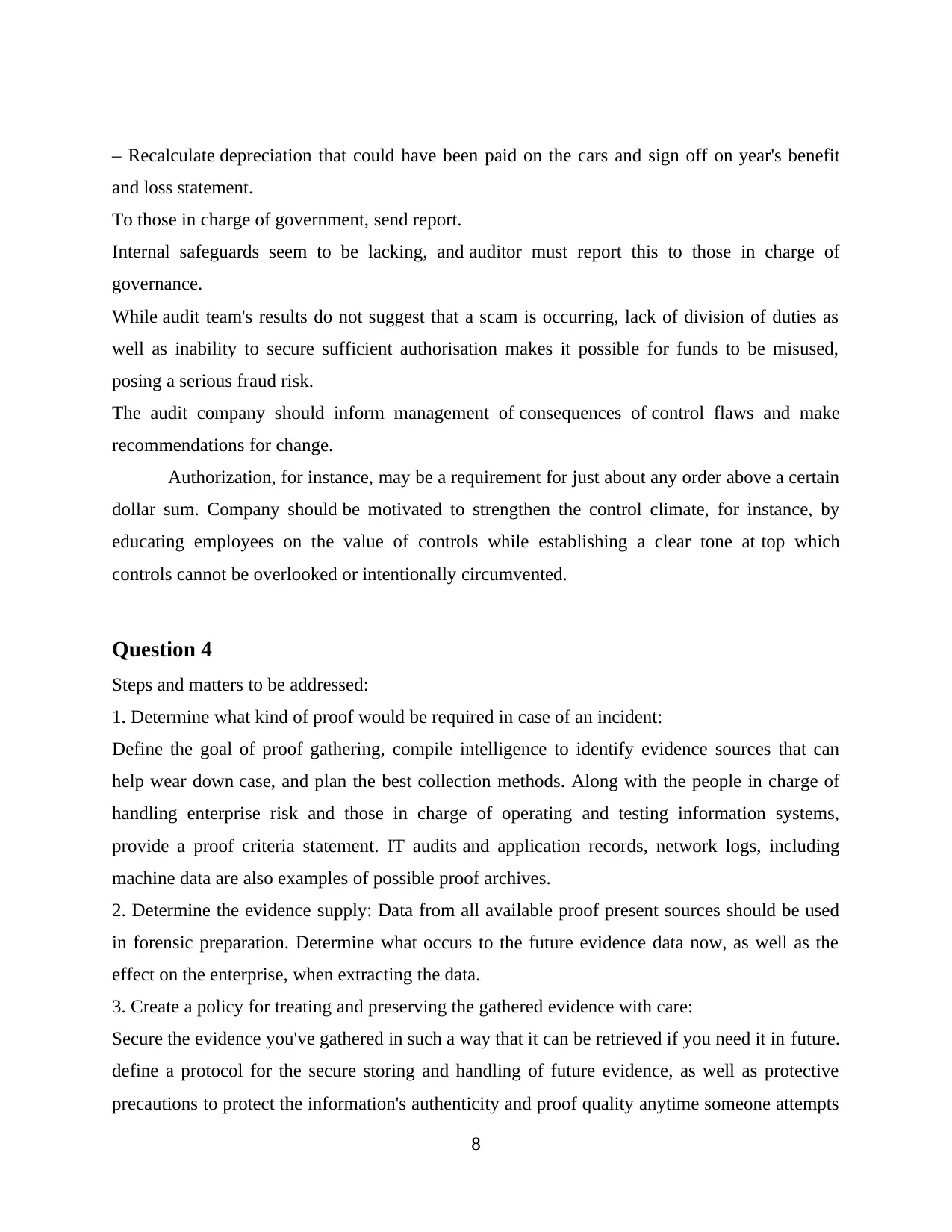
– Recalculate depreciation that could have been paid on the cars and sign off on year's benefit
and loss statement.
To those in charge of government, send report.
Internal safeguards seem to be lacking, and auditor must report this to those in charge of
governance.
While audit team's results do not suggest that a scam is occurring, lack of division of duties as
well as inability to secure sufficient authorisation makes it possible for funds to be misused,
posing a serious fraud risk.
The audit company should inform management of consequences of control flaws and make
recommendations for change.
Authorization, for instance, may be a requirement for just about any order above a certain
dollar sum. Company should be motivated to strengthen the control climate, for instance, by
educating employees on the value of controls while establishing a clear tone at top which
controls cannot be overlooked or intentionally circumvented.
Question 4
Steps and matters to be addressed:
1. Determine what kind of proof would be required in case of an incident:
Define the goal of proof gathering, compile intelligence to identify evidence sources that can
help wear down case, and plan the best collection methods. Along with the people in charge of
handling enterprise risk and those in charge of operating and testing information systems,
provide a proof criteria statement. IT audits and application records, network logs, including
machine data are also examples of possible proof archives.
2. Determine the evidence supply: Data from all available proof present sources should be used
in forensic preparation. Determine what occurs to the future evidence data now, as well as the
effect on the enterprise, when extracting the data.
3. Create a policy for treating and preserving the gathered evidence with care:
Secure the evidence you've gathered in such a way that it can be retrieved if you need it in future.
define a protocol for the secure storing and handling of future evidence, as well as protective
precautions to protect the information's authenticity and proof quality anytime someone attempts
8
and loss statement.
To those in charge of government, send report.
Internal safeguards seem to be lacking, and auditor must report this to those in charge of
governance.
While audit team's results do not suggest that a scam is occurring, lack of division of duties as
well as inability to secure sufficient authorisation makes it possible for funds to be misused,
posing a serious fraud risk.
The audit company should inform management of consequences of control flaws and make
recommendations for change.
Authorization, for instance, may be a requirement for just about any order above a certain
dollar sum. Company should be motivated to strengthen the control climate, for instance, by
educating employees on the value of controls while establishing a clear tone at top which
controls cannot be overlooked or intentionally circumvented.
Question 4
Steps and matters to be addressed:
1. Determine what kind of proof would be required in case of an incident:
Define the goal of proof gathering, compile intelligence to identify evidence sources that can
help wear down case, and plan the best collection methods. Along with the people in charge of
handling enterprise risk and those in charge of operating and testing information systems,
provide a proof criteria statement. IT audits and application records, network logs, including
machine data are also examples of possible proof archives.
2. Determine the evidence supply: Data from all available proof present sources should be used
in forensic preparation. Determine what occurs to the future evidence data now, as well as the
effect on the enterprise, when extracting the data.
3. Create a policy for treating and preserving the gathered evidence with care:
Secure the evidence you've gathered in such a way that it can be retrieved if you need it in future.
define a protocol for the secure storing and handling of future evidence, as well as protective
precautions to protect the information's authenticity and proof quality anytime someone attempts
8
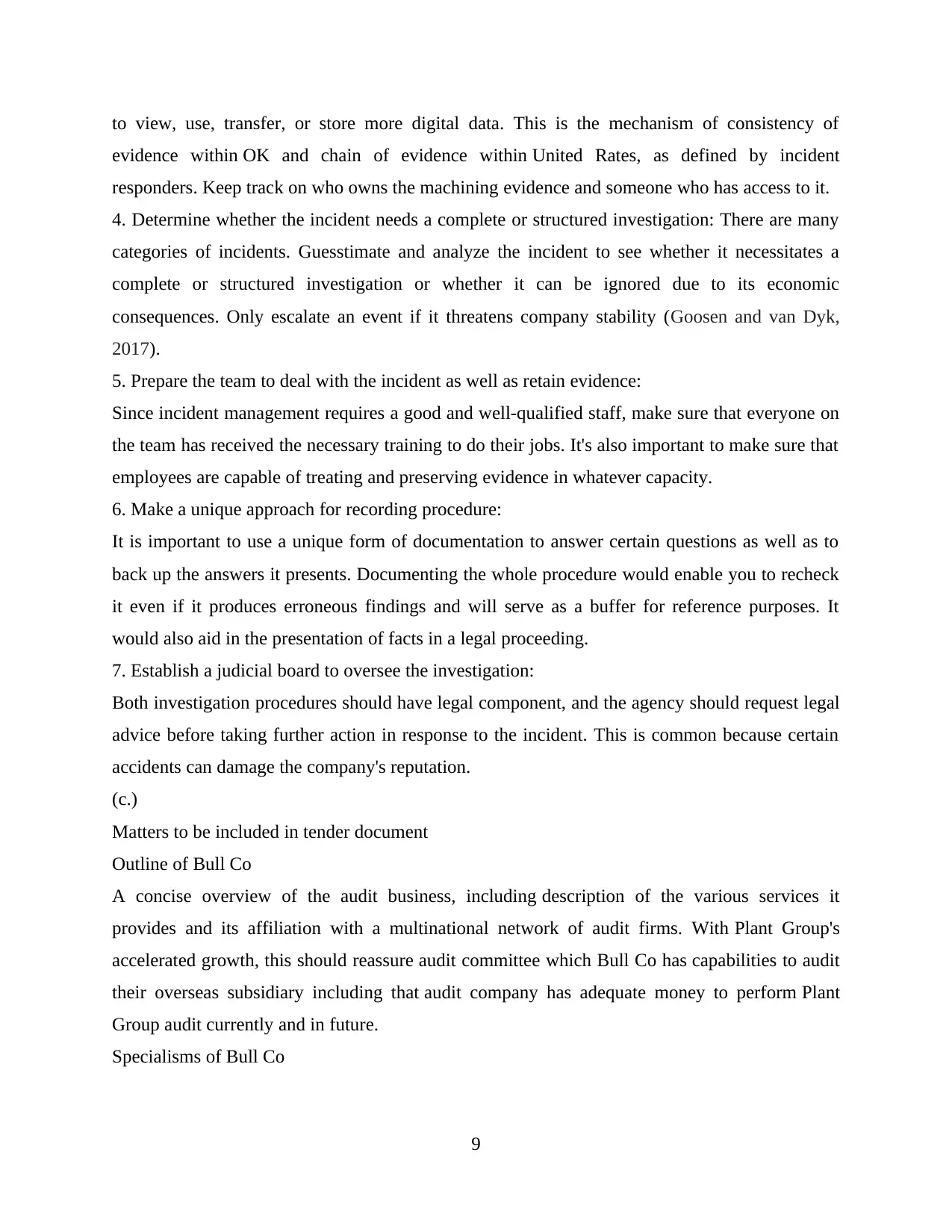
to view, use, transfer, or store more digital data. This is the mechanism of consistency of
evidence within OK and chain of evidence within United Rates, as defined by incident
responders. Keep track on who owns the machining evidence and someone who has access to it.
4. Determine whether the incident needs a complete or structured investigation: There are many
categories of incidents. Guesstimate and analyze the incident to see whether it necessitates a
complete or structured investigation or whether it can be ignored due to its economic
consequences. Only escalate an event if it threatens company stability (Goosen and van Dyk,
2017).
5. Prepare the team to deal with the incident as well as retain evidence:
Since incident management requires a good and well-qualified staff, make sure that everyone on
the team has received the necessary training to do their jobs. It's also important to make sure that
employees are capable of treating and preserving evidence in whatever capacity.
6. Make a unique approach for recording procedure:
It is important to use a unique form of documentation to answer certain questions as well as to
back up the answers it presents. Documenting the whole procedure would enable you to recheck
it even if it produces erroneous findings and will serve as a buffer for reference purposes. It
would also aid in the presentation of facts in a legal proceeding.
7. Establish a judicial board to oversee the investigation:
Both investigation procedures should have legal component, and the agency should request legal
advice before taking further action in response to the incident. This is common because certain
accidents can damage the company's reputation.
(c.)
Matters to be included in tender document
Outline of Bull Co
A concise overview of the audit business, including description of the various services it
provides and its affiliation with a multinational network of audit firms. With Plant Group's
accelerated growth, this should reassure audit committee which Bull Co has capabilities to audit
their overseas subsidiary including that audit company has adequate money to perform Plant
Group audit currently and in future.
Specialisms of Bull Co
9
evidence within OK and chain of evidence within United Rates, as defined by incident
responders. Keep track on who owns the machining evidence and someone who has access to it.
4. Determine whether the incident needs a complete or structured investigation: There are many
categories of incidents. Guesstimate and analyze the incident to see whether it necessitates a
complete or structured investigation or whether it can be ignored due to its economic
consequences. Only escalate an event if it threatens company stability (Goosen and van Dyk,
2017).
5. Prepare the team to deal with the incident as well as retain evidence:
Since incident management requires a good and well-qualified staff, make sure that everyone on
the team has received the necessary training to do their jobs. It's also important to make sure that
employees are capable of treating and preserving evidence in whatever capacity.
6. Make a unique approach for recording procedure:
It is important to use a unique form of documentation to answer certain questions as well as to
back up the answers it presents. Documenting the whole procedure would enable you to recheck
it even if it produces erroneous findings and will serve as a buffer for reference purposes. It
would also aid in the presentation of facts in a legal proceeding.
7. Establish a judicial board to oversee the investigation:
Both investigation procedures should have legal component, and the agency should request legal
advice before taking further action in response to the incident. This is common because certain
accidents can damage the company's reputation.
(c.)
Matters to be included in tender document
Outline of Bull Co
A concise overview of the audit business, including description of the various services it
provides and its affiliation with a multinational network of audit firms. With Plant Group's
accelerated growth, this should reassure audit committee which Bull Co has capabilities to audit
their overseas subsidiary including that audit company has adequate money to perform Plant
Group audit currently and in future.
Specialisms of Bull Co
9
⊘ This is a preview!⊘
Do you want full access?
Subscribe today to unlock all pages.

Trusted by 1+ million students worldwide
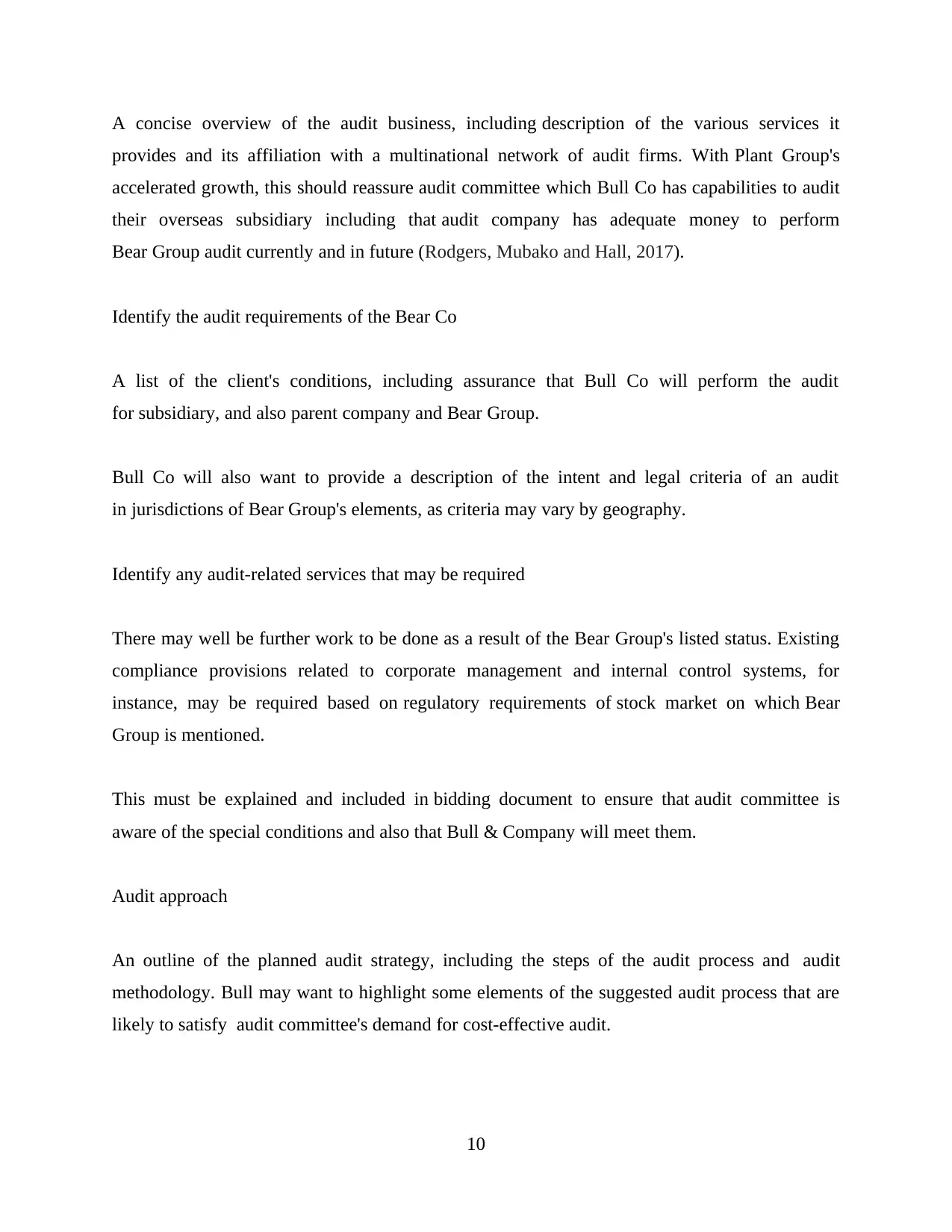
A concise overview of the audit business, including description of the various services it
provides and its affiliation with a multinational network of audit firms. With Plant Group's
accelerated growth, this should reassure audit committee which Bull Co has capabilities to audit
their overseas subsidiary including that audit company has adequate money to perform
Bear Group audit currently and in future (Rodgers, Mubako and Hall, 2017).
Identify the audit requirements of the Bear Co
A list of the client's conditions, including assurance that Bull Co will perform the audit
for subsidiary, and also parent company and Bear Group.
Bull Co will also want to provide a description of the intent and legal criteria of an audit
in jurisdictions of Bear Group's elements, as criteria may vary by geography.
Identify any audit-related services that may be required
There may well be further work to be done as a result of the Bear Group's listed status. Existing
compliance provisions related to corporate management and internal control systems, for
instance, may be required based on regulatory requirements of stock market on which Bear
Group is mentioned.
This must be explained and included in bidding document to ensure that audit committee is
aware of the special conditions and also that Bull & Company will meet them.
Audit approach
An outline of the planned audit strategy, including the steps of the audit process and audit
methodology. Bull may want to highlight some elements of the suggested audit process that are
likely to satisfy audit committee's demand for cost-effective audit.
10
provides and its affiliation with a multinational network of audit firms. With Plant Group's
accelerated growth, this should reassure audit committee which Bull Co has capabilities to audit
their overseas subsidiary including that audit company has adequate money to perform
Bear Group audit currently and in future (Rodgers, Mubako and Hall, 2017).
Identify the audit requirements of the Bear Co
A list of the client's conditions, including assurance that Bull Co will perform the audit
for subsidiary, and also parent company and Bear Group.
Bull Co will also want to provide a description of the intent and legal criteria of an audit
in jurisdictions of Bear Group's elements, as criteria may vary by geography.
Identify any audit-related services that may be required
There may well be further work to be done as a result of the Bear Group's listed status. Existing
compliance provisions related to corporate management and internal control systems, for
instance, may be required based on regulatory requirements of stock market on which Bear
Group is mentioned.
This must be explained and included in bidding document to ensure that audit committee is
aware of the special conditions and also that Bull & Company will meet them.
Audit approach
An outline of the planned audit strategy, including the steps of the audit process and audit
methodology. Bull may want to highlight some elements of the suggested audit process that are
likely to satisfy audit committee's demand for cost-effective audit.
10
Paraphrase This Document
Need a fresh take? Get an instant paraphrase of this document with our AI Paraphraser
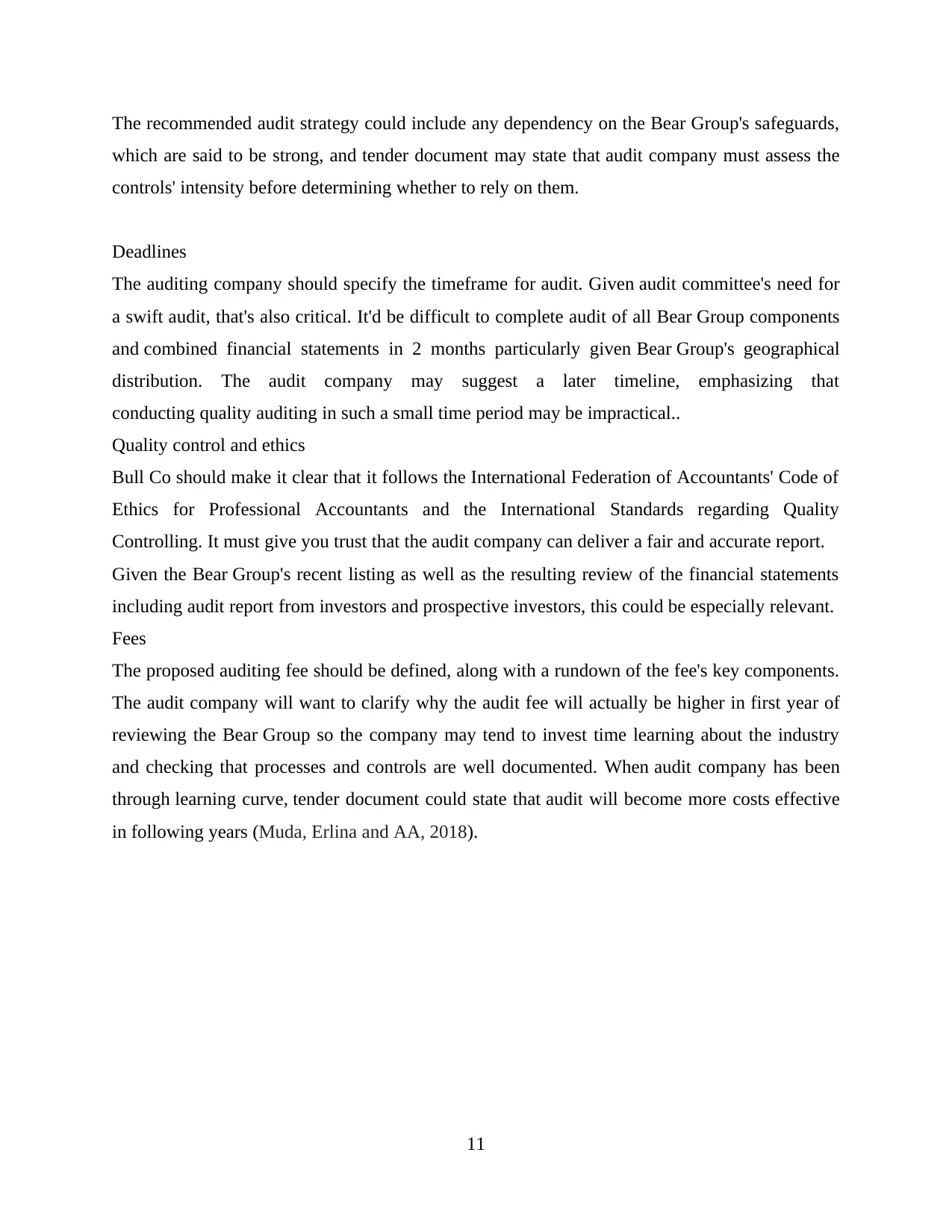
The recommended audit strategy could include any dependency on the Bear Group's safeguards,
which are said to be strong, and tender document may state that audit company must assess the
controls' intensity before determining whether to rely on them.
Deadlines
The auditing company should specify the timeframe for audit. Given audit committee's need for
a swift audit, that's also critical. It'd be difficult to complete audit of all Bear Group components
and combined financial statements in 2 months particularly given Bear Group's geographical
distribution. The audit company may suggest a later timeline, emphasizing that
conducting quality auditing in such a small time period may be impractical..
Quality control and ethics
Bull Co should make it clear that it follows the International Federation of Accountants' Code of
Ethics for Professional Accountants and the International Standards regarding Quality
Controlling. It must give you trust that the audit company can deliver a fair and accurate report.
Given the Bear Group's recent listing as well as the resulting review of the financial statements
including audit report from investors and prospective investors, this could be especially relevant.
Fees
The proposed auditing fee should be defined, along with a rundown of the fee's key components.
The audit company will want to clarify why the audit fee will actually be higher in first year of
reviewing the Bear Group so the company may tend to invest time learning about the industry
and checking that processes and controls are well documented. When audit company has been
through learning curve, tender document could state that audit will become more costs effective
in following years (Muda, Erlina and AA, 2018).
11
which are said to be strong, and tender document may state that audit company must assess the
controls' intensity before determining whether to rely on them.
Deadlines
The auditing company should specify the timeframe for audit. Given audit committee's need for
a swift audit, that's also critical. It'd be difficult to complete audit of all Bear Group components
and combined financial statements in 2 months particularly given Bear Group's geographical
distribution. The audit company may suggest a later timeline, emphasizing that
conducting quality auditing in such a small time period may be impractical..
Quality control and ethics
Bull Co should make it clear that it follows the International Federation of Accountants' Code of
Ethics for Professional Accountants and the International Standards regarding Quality
Controlling. It must give you trust that the audit company can deliver a fair and accurate report.
Given the Bear Group's recent listing as well as the resulting review of the financial statements
including audit report from investors and prospective investors, this could be especially relevant.
Fees
The proposed auditing fee should be defined, along with a rundown of the fee's key components.
The audit company will want to clarify why the audit fee will actually be higher in first year of
reviewing the Bear Group so the company may tend to invest time learning about the industry
and checking that processes and controls are well documented. When audit company has been
through learning curve, tender document could state that audit will become more costs effective
in following years (Muda, Erlina and AA, 2018).
11
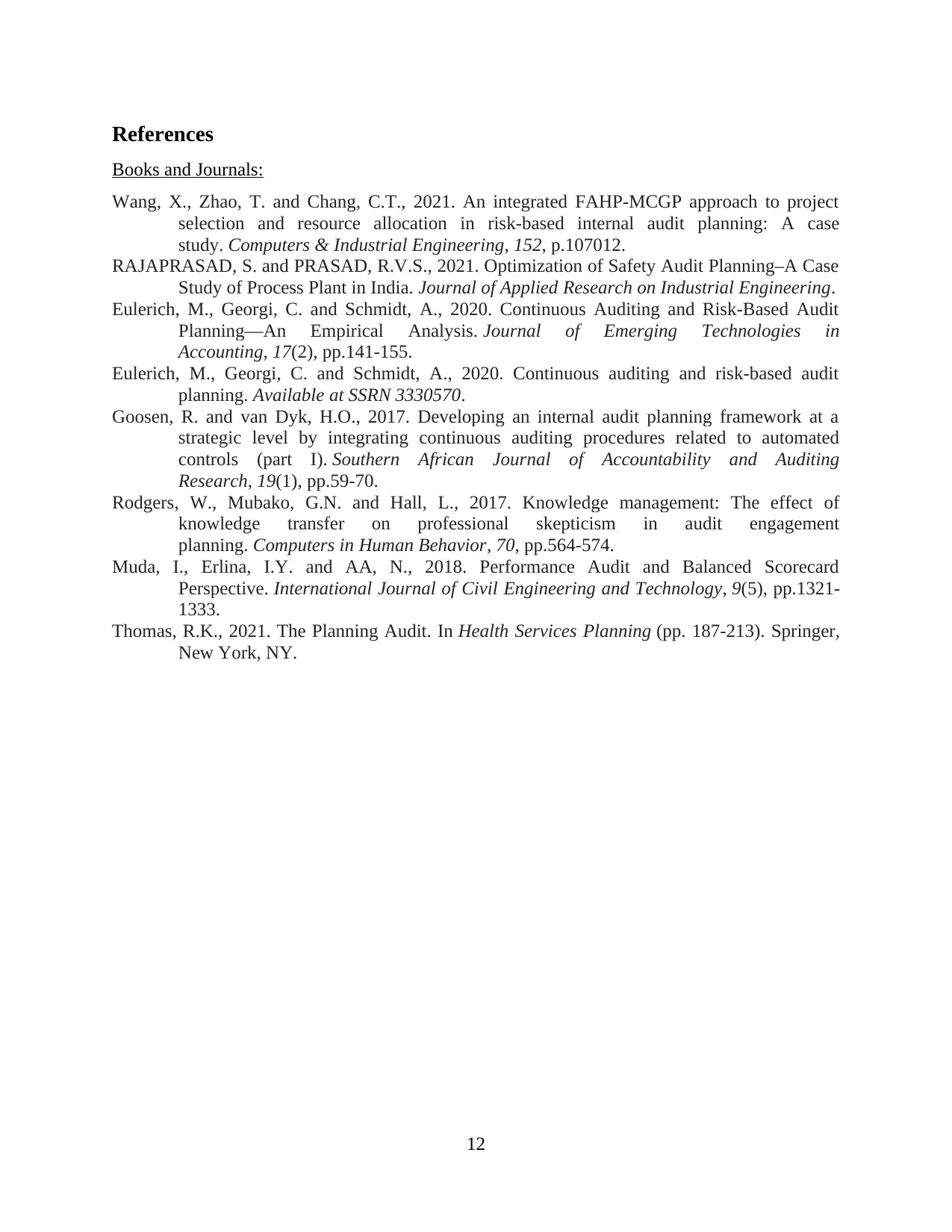
References
Books and Journals:
Wang, X., Zhao, T. and Chang, C.T., 2021. An integrated FAHP-MCGP approach to project
selection and resource allocation in risk-based internal audit planning: A case
study. Computers & Industrial Engineering, 152, p.107012.
RAJAPRASAD, S. and PRASAD, R.V.S., 2021. Optimization of Safety Audit Planning–A Case
Study of Process Plant in India. Journal of Applied Research on Industrial Engineering.
Eulerich, M., Georgi, C. and Schmidt, A., 2020. Continuous Auditing and Risk-Based Audit
Planning—An Empirical Analysis. Journal of Emerging Technologies in
Accounting, 17(2), pp.141-155.
Eulerich, M., Georgi, C. and Schmidt, A., 2020. Continuous auditing and risk-based audit
planning. Available at SSRN 3330570.
Goosen, R. and van Dyk, H.O., 2017. Developing an internal audit planning framework at a
strategic level by integrating continuous auditing procedures related to automated
controls (part I). Southern African Journal of Accountability and Auditing
Research, 19(1), pp.59-70.
Rodgers, W., Mubako, G.N. and Hall, L., 2017. Knowledge management: The effect of
knowledge transfer on professional skepticism in audit engagement
planning. Computers in Human Behavior, 70, pp.564-574.
Muda, I., Erlina, I.Y. and AA, N., 2018. Performance Audit and Balanced Scorecard
Perspective. International Journal of Civil Engineering and Technology, 9(5), pp.1321-
1333.
Thomas, R.K., 2021. The Planning Audit. In Health Services Planning (pp. 187-213). Springer,
New York, NY.
12
Books and Journals:
Wang, X., Zhao, T. and Chang, C.T., 2021. An integrated FAHP-MCGP approach to project
selection and resource allocation in risk-based internal audit planning: A case
study. Computers & Industrial Engineering, 152, p.107012.
RAJAPRASAD, S. and PRASAD, R.V.S., 2021. Optimization of Safety Audit Planning–A Case
Study of Process Plant in India. Journal of Applied Research on Industrial Engineering.
Eulerich, M., Georgi, C. and Schmidt, A., 2020. Continuous Auditing and Risk-Based Audit
Planning—An Empirical Analysis. Journal of Emerging Technologies in
Accounting, 17(2), pp.141-155.
Eulerich, M., Georgi, C. and Schmidt, A., 2020. Continuous auditing and risk-based audit
planning. Available at SSRN 3330570.
Goosen, R. and van Dyk, H.O., 2017. Developing an internal audit planning framework at a
strategic level by integrating continuous auditing procedures related to automated
controls (part I). Southern African Journal of Accountability and Auditing
Research, 19(1), pp.59-70.
Rodgers, W., Mubako, G.N. and Hall, L., 2017. Knowledge management: The effect of
knowledge transfer on professional skepticism in audit engagement
planning. Computers in Human Behavior, 70, pp.564-574.
Muda, I., Erlina, I.Y. and AA, N., 2018. Performance Audit and Balanced Scorecard
Perspective. International Journal of Civil Engineering and Technology, 9(5), pp.1321-
1333.
Thomas, R.K., 2021. The Planning Audit. In Health Services Planning (pp. 187-213). Springer,
New York, NY.
12
⊘ This is a preview!⊘
Do you want full access?
Subscribe today to unlock all pages.

Trusted by 1+ million students worldwide
1 out of 12
Your All-in-One AI-Powered Toolkit for Academic Success.
+13062052269
info@desklib.com
Available 24*7 on WhatsApp / Email
![[object Object]](/_next/static/media/star-bottom.7253800d.svg)
Unlock your academic potential
Copyright © 2020–2025 A2Z Services. All Rights Reserved. Developed and managed by ZUCOL.
